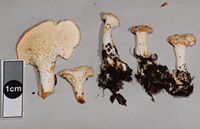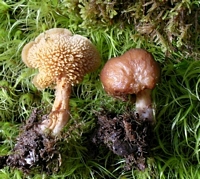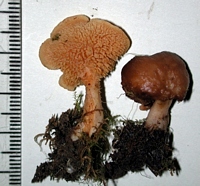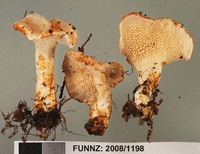|
 Hydnum crocidens var. wellingtonii Hydnum crocidens var. wellingtonii
SynonymsHydnum wellingtonii
BiostatusPresent in region - Indigenous. Endemic
Images (click to enlarge)
Owner: J.A. Cooper | 
Caption: fruitbodies in moss (inc. sphagnum)
Owner: J.A. Cooper | 
Owner: J.A. Cooper | 
Owner: J.A. Cooper | |
Article: McNabb, R.F.R. (1971). Some new and revised taxa of New Zealand Basidiomycetes (Fungi). New Zealand Journal of Botany 9(2): 355-370 (http://www.rsnz.org/publish/abstracts.php).
Description: Pileus 0.7-4.5 cm diam., broadly spathulate, orbicular, or reniform, pallid creamy white, often with faint shell pink tints, stained with ochraceous or rusty brown patches when overmature. Hymenial surface concolorous with pileus: spines decurrent to deeply decurrent, to 5 mm long, crowded, pallid creamy white, darkening with age. Stipe lateral or less frequently excentric, 1-3 cm long, 3-5 mm diam. Spores globose, subglobose, or occasionally broadly elliptical, hyaline, thin-walled, readily collapsing, 7.7-9-(9.8) x 7-8.5 µm, smooth.
Habitat: Solitary or gregarious under Nothofagus.
Distribution: TYPE LOCALITY: York Bay. Wellington, New Zealand.
Notes: Although Lloyd's description of Hydnum wellingtonii is inaccurate in many respects an isotype is typical of the beech forest form of H. crocidens. Var. wellingtonii may be distinguished from var. crocidens by the broadly spathulate, orbicular, or reniform pileus, excentric or lateral stipe, decurrent spines, and slightly larger spores. It appears to be restricted to Nothofagus-dominated habitats.
|